16 January, 2003
Beautiful Summer Day
I spent two days trying to respond to some of your e-mail questions and
comments, so I would like to backtrack a little to our activities from
yesterday, as it was an amazing day.
We awoke to a spectacular summer morning, Antarctica style. The sky was
brilliant blue with just a few puffy cumulus clouds drifting high above the
mountains. The contrast of the blue sky, the glistening white ice from the
glaciers and lake, and the calico colors of the mountains made the entire
scene seem artificial. The temperature was 28 degrees and the air was clean
and crisp. We had all dragged ourselves out of our tents, but quickly
returned to them, dashing back to grab our cameras. We had become accustomed
to cloudy days with a healthy east wind of up to 25 knots. But today, we
saw only fair weather clouds and the wind was just a gentle breeze from the
west.
We had a bit of a late start onto the ice because we were all enjoying the
views from this beautiful morning, but when we finally arrived at our coring
site, we were raring to go. We obtained some core samples and prepared two
more sites by boring holes into the ice. During the afternoon, I went back
into the hut to work on my journals. Soon, I was interrupted by Erin, from
LTER, who came in reporting that her team had just seen an Adelie penguin
about a twenty-minute walk away, east down the valley. Sarah and I grabbed
our cameras and set off to have a look.
In no time at all, we came upon the penguin on the ground just off the lake
ice. We kept our distance and watched him for a bit. Soon he stood up and
walked towards us. We stood very still and quiet as he approached, and then
stopped about ten feet away from us. He looked tired and seemed content to
just lie there for a long while. It was exciting to see a penguin in the
wild. Erin told us that she had watched him take a quick swim in the moat
area of the lake and then pop up again to rest. Sarah and I took several
photos and then headed back to the jamesway.
About an hour later, Brenda came into the hut where I was working at the
computer and said the penguin had continued up the valley and was now
passing our camp. He was now over 15 miles from the coast and further yet to
open water. I grabbed my cameras again and dashed outside to take some
pictures because most of the ones I had taken earlier were of the penguin
lying down. We could barely catch up to him as he hurried his way along the
ice. I had to walk briskly to keep pace with him and run ahead if I wanted
a photo of him approaching me. This plump little penguin was amusing to
watch, moving so quickly, yet constantly trying to remain standing, as his
feet would slip on the ice causing him to lose his balance. He never fell
over, but he teetered with nearly every step.
It is not entirely unusual for penguins and seals to move up valley. The
animals that do this are generally young, but no one really knows why they
travel in a direction that leads them away from open water. Sadly, some
wander so far inland that they are unable to find food and perish.
All day long, I was anxious to go hiking and to travel up to higher grounds
to take advantage of the clear views throughout the valley. At about
7:00pm, Sean came in with Tom saying that they were going to skip dinner and
go for a hike... was I game? I quickly gathered my cameras and packed up a
backpack with water, snacks, and the ever-present "P" bottle.
We set off for Bonney Riegel. It was an hour hike to this point heading
west up Taylor Valley. When we arrived at the top of Riegel, the view was
amazing. We were able to see the east lobe of Lake Bonney and our camp
looking east. As we faced west, we overlooked the west lobe of Lake Bonney
and the Taylor Glacier with its giant crevasses. In the distance we could
see mountains with a very distinct dolerite sill cutting through the Beacon
Sandstone. The sun was just over this area during our hike, so I held off on
the photos of this, but will include some later.
After enjoying the view from Riegal, we headed south increasing our
elevation, until we saw a truly spectacular site. Looking west, well beyond
the massive Taylor Glacier, rising up to elevate the horizon, was the East
Antarctic Ice Sheet. This is the largest ice sheet in the world, over three
miles thick in places, and contains 78 percent of our world's fresh water.
The East Antarctic Ice Sheet is similar in size to the Laurentide Ice Sheet
that covered much of North America during the last glaciation of the
Northern Hemisphere.
We continued climbing yet again until we reached the snout of Hughes
Glacier. It is extremely difficult to describe how enormous a glacier is
when you are standing next to it. Suffice to say, it is a very humbling
experience. I have tried to capture the majesty of this area, and will
continue to try to do so. Sometimes a photo is worth a thousand words, and
other times a photo just fails to capture the essence of a scene. I think
maybe my photos fall somewhere in between.

Adelie penguin by the side of the lake when we first came upon him.
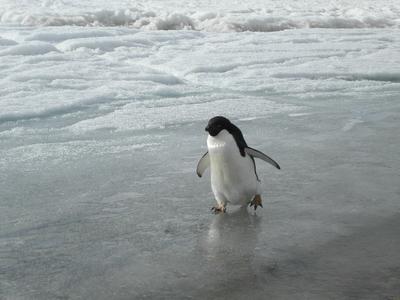
The Adelie penguin speeding by our Lake Bonney camp.

Standing at the top of Bonney Reigal with the east lobe of Lake Bonney in the background.

We call this the Swiss Cheese Rock. It was carved from wind, so again it is called a ventifact. This a a huge one measuring about 15 feet high.
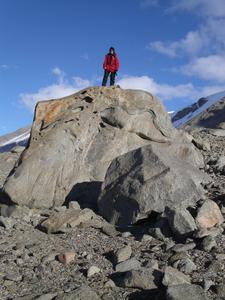
On top of another giant ventifact. Notice the very rocky and sandy terrain, which makes hiking very difficult. Much of the valley is silt, covered with a thin layer of gravel and rocks. In some places you take a step and can sink in two or three inches, especially on the steeper slopes or near the lakes.
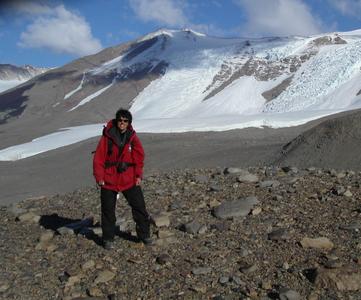
Still on our way to Hughes Glacier seen here in the background. Things here seem close because they are so big, but what appears to be a10 minute walk away, can actually be an hour away.

This is Sean at the snout of Hughes Glacier. With someone in the photo, it provides some perspective as to just how tremendous this glacier is at 70 feet high. Again, I apologize for the "frozen" shutter causing some black shadows on the picture.
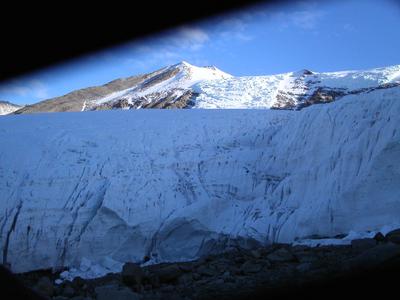
This was taken at the snout of Hughes Glacier. Notice the recently calved pieces of ice at the base. Four times now since we have been camping here at Bonney, we have heard the thunderous roar that wakes you from a sound sleep, as the glaciers shift and giant ice chunks calve off onto the mountainside.
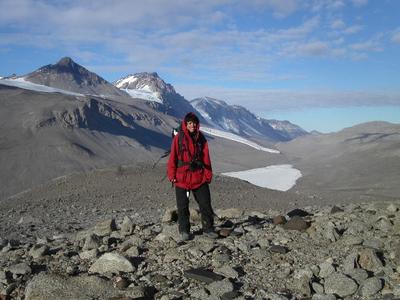
As we climbed higher above Bonney Riegel, the winds picked up. This is a view again towards the east. The first peak on the left is called the Matterhorn. LaCroix Glacier is the white patch moving into the valley, and that's Lake Bonney (east lobe) at the bottom of the valley.
Contact the TEA in the field at
.
If you cannot connect through your browser, copy the
TEA's e-mail address in the "To:" line of
your favorite e-mail package.
|
